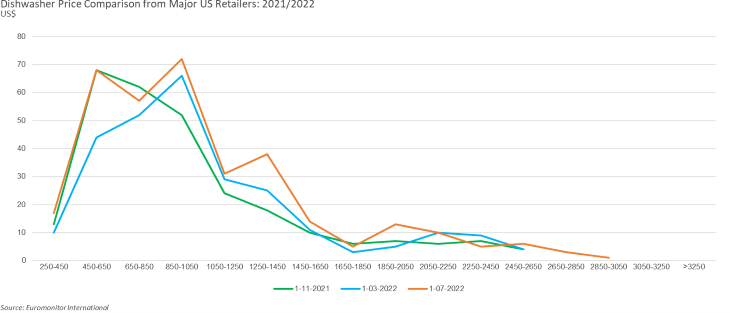At the beginning of 2022, the appliances industry was facing a myriad of challenges: high inflationary pressures caused by exceptional commodity prices, expensive logistics costs, and a shortage of parts. Since then, input costs have somewhat decreased due to recessionary fears. Nonetheless, prices of appliances are expected to remain elevated due to high energy prices, continued semiconductor shortages, and lockdowns in China.
Inflationary drivers persist
Inflation continues to rise and is now expected to reach 9.9% in emerging and developing markets and 6.5% in advanced economies in 2022, with this trend likely to remain relevant into 2023. However, recessionary fears have now eclipsed it as a key concern for most.
Housing markets, a highly correlated indicator of future appliances spending, have slowed down. In the US, according to the National Association of Realtors, July sales dropped by 5.9% from the previous month and by 20% from 2021, continuing a downward trend.
Pandemic-driven lockdowns in China, which are starting to hamper supply chains, are likely to exacerbate the shortage of some categories, especially major appliances. China accounts for 60-70% of global appliance production capacity, of which, air conditioners, refrigerators, and small appliances constitute the top three categories.
Elevated prices in appliances are expected to remain sticky as retailers grapple with inflationary pressures from wages, interest rates, and utilities. Most of the products currently on retailers’ shelves were also manufactured when input costs were close to their peaks.
Inflation will continue to undermine consumer confidence
Inflationary pressures continue to rise as countries worldwide are hit by persisting problems in the supply chain and rising commodity prices. Given the intensified inflationary pressures, many central banks worldwide have increased their interest rates to tame high inflation. Tighter global financial conditions, especially the US dollar’s strength, could result in financial distress for emerging and developing markets, further affecting the global economic outlook. For developed markets, higher interest rates have impacted the housing market, and had a knock-on effect on the sales of appliances.
Elevated prices remain sticky
Historical findings have shown that inflation in appliances was sticky. To better quantify this trend, Euromonitor International continued its price check on dishwashers from major brands distributed by leading US retailers. The checks show that although median price rises have slowed, increasing from USD944 to USD949 (March-July 2022) compared to USD849 in November 2021, the price range has increased significantly; the upper limit of the price range has extended from USD2,450-2,650 to USD2,850-3,050 (March-July 2022). The increase in price range is likely to be due to a perceived lower elasticity of demand for premium appliances – consumers purchasing a USD2,800 dishwasher are unlikely to mind or notice a 10% price increase.
Higher-priced appliances are also more readily available as manufacturers prioritise big-ticket items with greater profit margins. A continued chip shortage is another cause for this prioritisation. In other words, consumers are struggling to find cheaper entry-level appliances.
High prices are likely to persist. Retailers are also not lowering prices as inflationary pressures from wages, interest rates, and utilities continue.

Another uncertain period ahead for the appliances industry
Moving into 2023, inflation is expected to stay above-trend. For the appliances industry, energy prices and labour costs are expected to remain the key inflation drivers.
With some analysts predicting that the housing market downturn will be worse in 2023 as interest rates continue to rise, both new and replacement purchases could be equally affected.
A further downturn in the housing market will translate into lower demand, which would normally lead to lowered prices. However, prices of appliances are expected to remain high due to high energy prices, continued semiconductor shortages, and lockdowns in China.
For further insight, read Euromonitor International’s briefing, Inflation Surge: Consumer Appliances
